KEY TAKEAWAYS
The Food Import Crisis: Nigeria, with its arable potential, still spends over $10 billion annually on food imports, a gap Precision Agriculture (PA) is uniquely poised to close.
The Productivity Imperative: PA can deliver an average increase in crop yields of 25–30% in smallholder settings, directly bolstering national food supply.
Efficiency in Action: The use of Variable Rate Technology (VRT) in applications like drone spraying has been shown to reduce agricultural input waste (fertilizers, agrochemicals) by at least 60%.
Economic Viability: For medium-to-high capital investments in PA technologies, studies show the initial capital outlay can be recovered within 2 to 5 years.
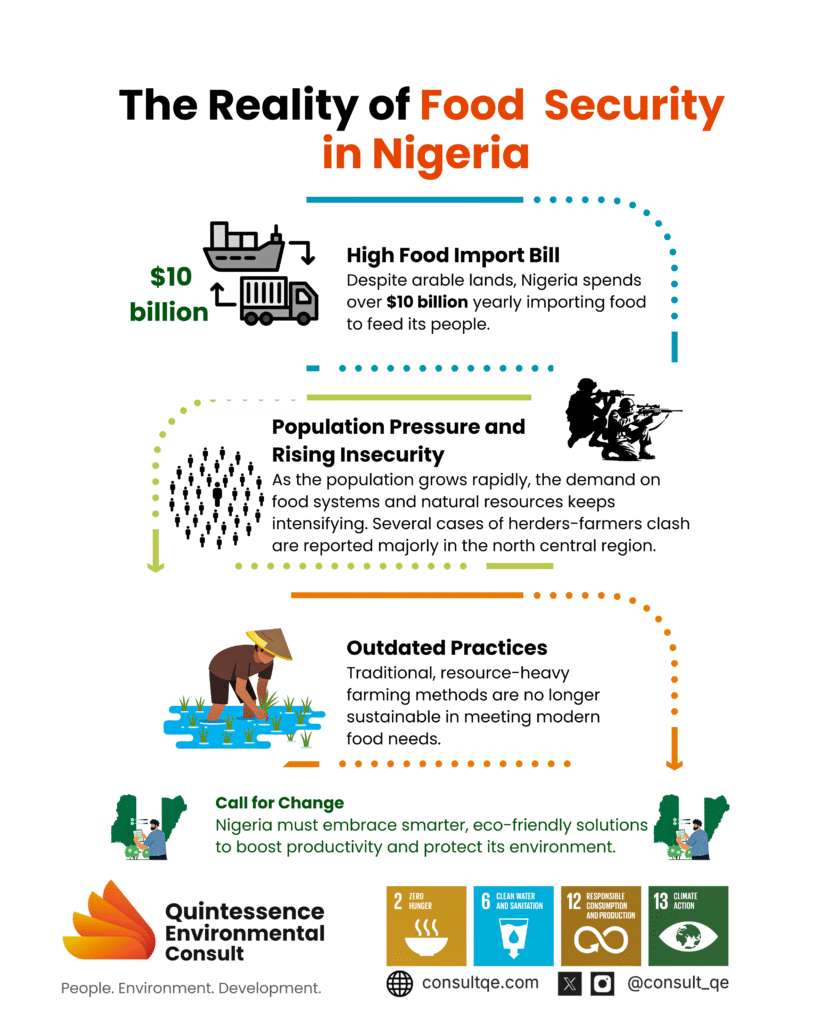
BACKGROUND
Nigeria, Africa’s most populous nation, stands at a critical juncture where a rapidly increasing population meets the urgent need for enhanced food security and sustainable agricultural practices. Nigeria currently spends over $10 billion annually on food imports, despite its vast agricultural potential, highlighting a significant production gap [9]. The conventional, often resource-intensive farming methods, particularly those used by the smallholder farmers, are no longer sufficient to meet soaring food demand while mitigating environmental impact. Precision agriculture, also known as smart farming, directly addresses this by optimizing growing conditions.
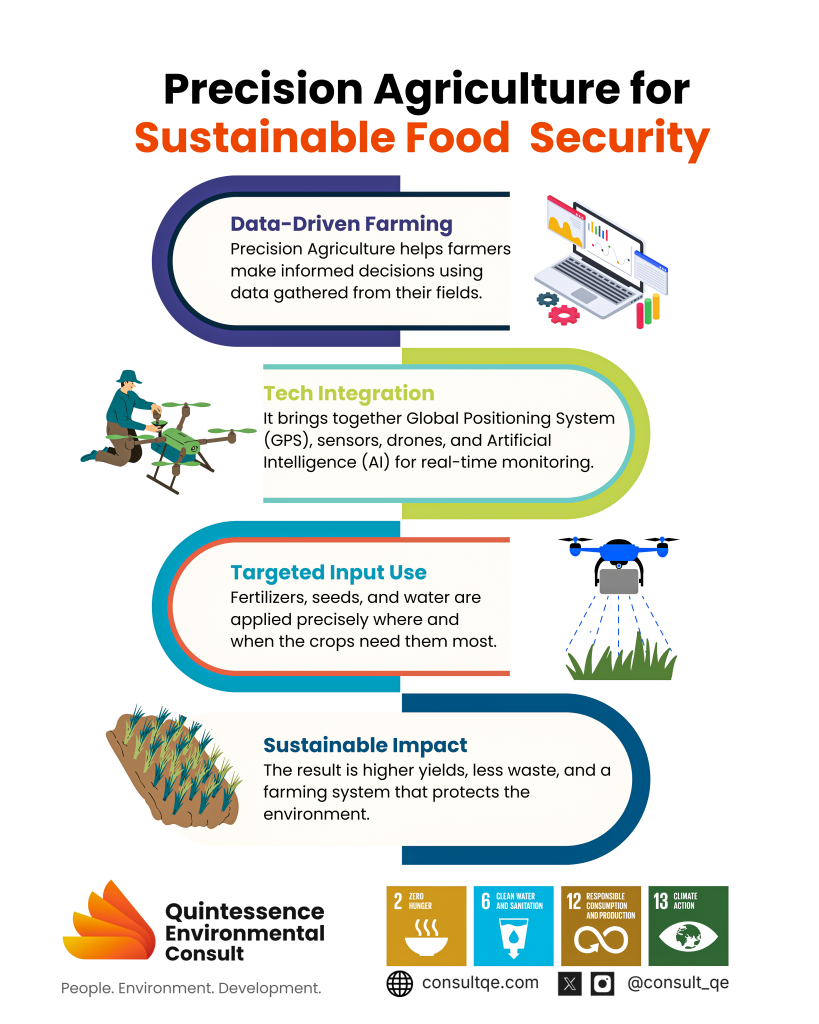
WHAT IS PRECISION AGRICULTURE?
Gone are the days when farming was purely about intuition and experience. Modern agriculture is undergoing a profound transformation, driven by an array of sophisticated technologies. This is not just about bigger tractors; it is about smarter farming, managing every inch of your land with unprecedented accuracy and efficiency. Welcome to the world of Precision Agriculture (PA), where data is the new harvest.
Precision Agriculture is a farm management strategy that utilizes advanced technologies to observe, measure, and respond to spatial and temporal variability in crops and soil within a field. Instead of treating an entire field uniformly, precision agriculture applies the right amount of input (fertilizer, water, pesticides, seeds), at the right place, and at the right time [1]. But how does it achieve this? Let’s peel back the layers and explore the core technologies making this revolution possible. This data-driven approach is made possible by integrating cutting-edge tools: Like Remote Sensing (Satellites and Drones), Global Positioning System (GPS) and Geographic Information System (GIS), Variable Rate Technology (VRT), and Sensors and Internet of Things (IoT) [2,3].
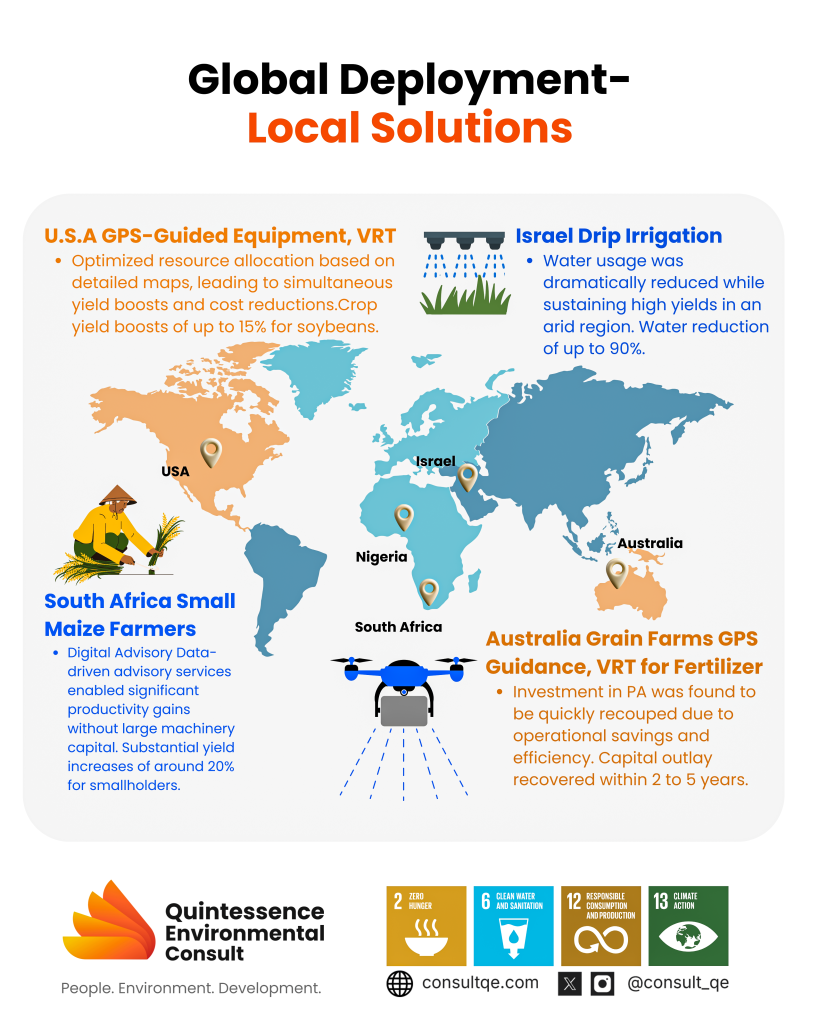
PRECISION AGRICULTURE IN ACTION: CASE STUDIES
1. International Case Study: Demonstrating Economic Returns
I. Israel
The adoption of drip irrigation in Israel demonstrates the critical value of resource efficiency in challenging environments. Facing severe water scarcity, Israel pioneered this technology, which precisely delivers water and nutrients directly to plant roots. The dramatic reduction of water usage is reported to be up to 90% in some applications while ensuring high yields, proving that advanced, targeted applications can sustain and increase food production in arid regions [13,14].
II. United States of America (US)
The large-scale farms in the United States highlight the economic power of precision agriculture adoption by leveraging sophisticated tools like GPS-guided equipment and Variable Rate Technology (VRT). US farmers have shifted management from the field-level to the sub-field level, optimizing resource allocation based on detailed soil and yield maps. The US simultaneously achieved the goals of boosting crop yields up to 15% for soybeans and lowering input costs. And further enabled the US to produce the same amount of wheat in 2018 using 8 million fewer acres than in 1990, which also carries the indirect benefit of reducing the environmental footprint of expansive agricultural operations[13].
III. The Australian Grain Farms
A study on Australian grain farms, where farmers made medium-to-high capital investments (ranging from $55,000 to $189,000) in precision agriculture technologies like GPS guidance and VRT for fertilizer, showed quick returns [6]. The estimated annual benefits ranged from $14 to $30 per hectare, with the initial capital outlay being recovered within 2 to 5 years, and in four out of six cases, within 2-3 years. The benefits included up to 10% savings on spraying costs due to reduced overlap [6]. This demonstrates that with sufficient scale and proper implementation, precision agriculture is a profitable investment.
IV. South Africa Smallholder Maize Farmers
Smallholder maize farmers in South Africa utilize drone imaging and digital information systems developed by institutions like the Council for Scientific and Industrial Research. The focus shifts from capital-intensive machinery to providing actionable, real-time data and early warnings. These simple data-driven advisory services significantly improve livelihoods and national food security by projecting substantial yield increases of around 20% for smallholders [12].
Overall, the global experience showcases the clear economic viability of substantial precision agriculture investment.
- Local Case Study: Targeting Smallholder Farmers
A major challenge in Nigeria is the predominance of smallholder farmers. However, emerging agritech firms are finding ways to bring precision agriculture benefits to them.
I. Case Study: Digital Platforms for Smallholder Advice
Firms like Farmonaut and others are using satellite-based crop health monitoring to provide real-time insights into vegetation health and soil moisture to Nigerian farmers [7]. This technology enables informed decisions on irrigation and fertilizer use, optimizing crop yields and reducing resource wastage, particularly valuable in regions with unpredictable rainfall. Other key practitioners include AirSmat Inc., Agroxchange Technology Services Limited, and Hello Tractor, which focus on AI-driven software, satellite crop health, and equipment sharing platforms, respectively
II. Case Study: Drone Technology in South-East Nigeria
In a case working with smallholder farmers in South-East Nigeria, the introduction of precision agriculture using drones for farm data collection, mapping, and fertility distribution analysis demonstrated its superiority over traditional methods [8]. The use of input spray drones with Variable Rate Technology (VRT) was found to reduce agricultural input waste by at least 60%, validating the efficiency of site-specific application [8].
NOTABLE PRECISION AGRICULTURE EQUIPMENT FOR SUSTAINABLE FOOD SECURITY
For sustainable food security, precision agriculture equipment and systems that focus on efficiency, resource optimization, and data-driven decision-making are critical.
Agricultural Drones (UAVs) for Crop Monitoring & Mapping: Rapidly assess crop health (e.g., via multispectral imagery), soil conditions, and pest/disease outbreaks over large areas. As well as precision input application for variable-rate spraying of fertilizers, pesticides, and herbicides, reducing chemical usage and cost.
GPS-Guided Tractors/Machinery: This enables precise tillage (minimizing soil disturbance) and accurate planting and harvesting, reducing overlap, conserving fuel, and improving overall field efficiency.
Variable Rate Technology (VRT) Applicators: Equipment (spreaders, sprayers) capable of changing the application rate of inputs (seeds, fertilizer, lime) based on site-specific prescription maps generated from PA data. This maximizes input efficiency and reduces environmental runoff.
Soil and Weather Sensors (IoT): Real-time data collection on soil moisture, pH levels, nutrient content, and local micro-weather conditions, allowing for optimized irrigation and nutrient management.
Geographic Information Systems (GIS): Software platforms are used to process, analyze, and visualize spatial data (e.g., drone maps, soil samples, yield data) to create prescription maps for VRT equipment.
AI-Powered Advisory Systems: Mobile apps and platforms that use satellite and drone data, combined with machine learning, to provide personalized, actionable recommendations for farmers on planting, fertilizing, pest management, and irrigation.
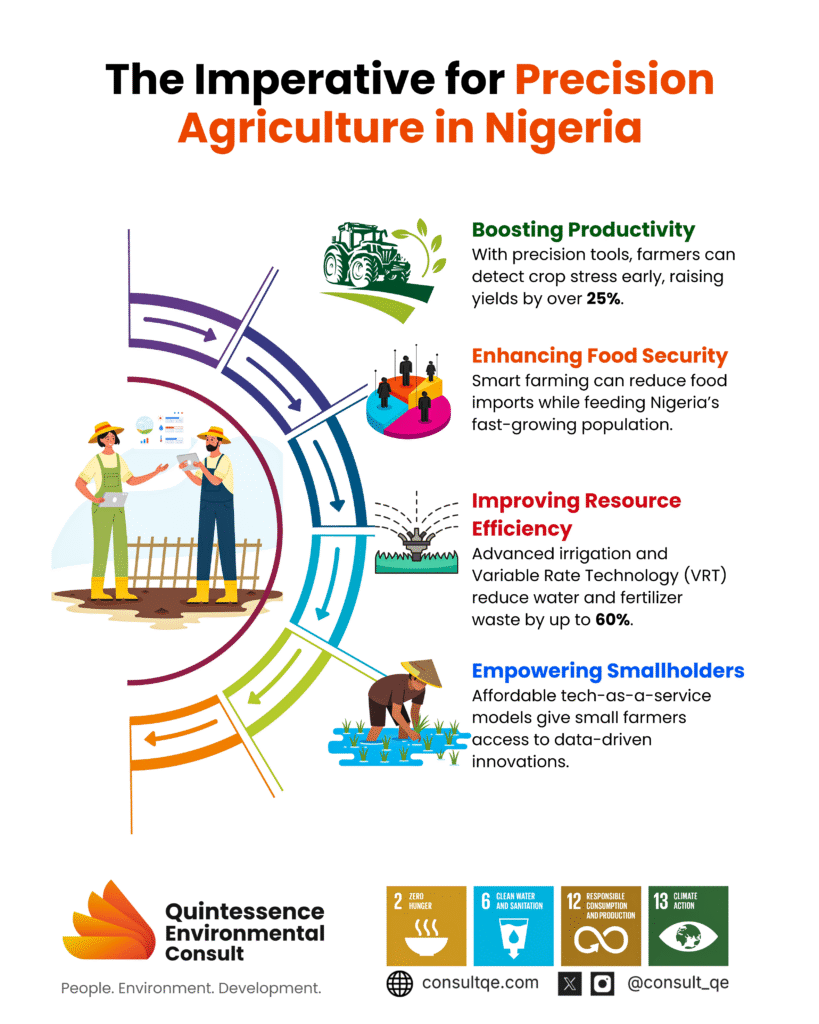
THE IMPERATIVE FOR PRECISION AGRICULTURE IN NIGERIA
Nigeria’s agriculture sector, which contributes significantly to the GDP and employs almost two-thirds of the total working population [11], faces persistent challenges that precision agriculture is uniquely positioned to address:
- Addressing Regional Needs and Adoption Gaps: Needs assessment studies reveal significant regional disparities in PA adoption. The Southwest shows higher awareness, while the Northern and Middle Belt regions struggle more due to inadequate infrastructure and limited extension services [16]. This highlights a specific need for resource efficient precision agriculture solutions, such as drip irrigation and soil moisture sensors, in arid and semi-arid zones to manage critical water scarcity.
- Boosting Productivity and Yields: Studies have shown that precision agriculture technologies can lead to increased productivity for a majority of farmers. For example, a study in Lagos State indicated that 87% of participants agreed that precision agriculture technology would make farm managers more efficient, and 85% of adopters agreed that it contributed significantly to their farm’s financial profitability and yield improvement [10]. By precisely detecting crop stress from pests or nutrient deficiency using drones or satellite imagery, farmers can apply targeted treatments, preventing widespread crop loss and maximizing harvest.
- Combating Food Insecurity and Rising Demand: Nigeria’s population growth necessitates a massive, sustainable increase in food production. Conventional farming often leads to uneven yields and wastage. Precision agriculture, by optimizing growing conditions, has been shown to deliver an average increase in crop yields of 25-30% in smallholder settings, directly bolstering national food supply and reducing reliance on imports [4].
- Enhancing Resource Efficiency: Traditional farming often involves the indiscriminate use of inputs like fertilizers and water, leading to waste and environmental degradation. Smart irrigation systems use soil moisture sensors to apply water only when and where it is needed, conserving a vital resource, especially in semi-arid regions [2]. Variable Rate Technology (VRT) on equipment, such as spray drones, can reduce input waste (fertilizers, agrochemicals) by as much as 60%, significantly lowering operational costs for farmers and increasing profitability [1, 4].
- Alignment with Government Policy (NATIP): The adoption of Precision agriculture is directly supported by the Federal Government’s National Agricultural Technology and Innovation Policy (NATIP) 2022-2027, which places a strong emphasis on modernizing the agricultural sector through technology, innovation, and digital and climate-smart agriculture [17]. Policies like the National Agriculture Growth Scheme Agro-Pocket (NAGS-AP) for input delivery are foundational systems that PA can optimize, ensuring inputs reach the right farmer and are used with precision. Furthermore, initiatives like the Energizing Agriculture Program (EAP), which promotes decentralized renewable energy (DRE) for agriculture, are crucial for powering the sensors and charging stations needed for PA technology [18].
- Empowering Smallholder Farmers : The Role of Practitioners i.e. Smallholder farmers, who produce the majority of Nigeria’s food, often lack the capital and knowledge to maximize their productivity. Nigerian agritech companies like Hello Tractor (tractor sharing), Agroxchange (satellite-based advisory via SMS), and AirSmat Inc. (AI-driven farming) are pioneering affordable “Technology-as-a-Service” models. These models democratize access to sophisticated tools, providing data-driven insights that overcome the guesswork of traditional methods, enabling smallholders to become formidable food producers [1, 4, 19, 10].
- Promoting Environmental Sustainability: By reducing the overuse of agrochemicals, precision agriculture minimizes nutrient runoff and leaching into water bodies, protecting soil health and the environment. It aligns directly with the goal of Climate-Smart Agriculture by building resilience in farming systems.
- New Service Opportunities: The adoption creates a new market for Agri-Tech service providers who own the expensive equipment and offer ‘Drone-as-a-Service’ (DaaS) to multiple smallholder or commercial farmers on a subscription or pay-per-use basis. This democratizes access to the technology.
- Informed Decision Making : The data gathered empowers farmers with actionable insights for better farm planning, resource allocation, and market decisions (e.g., yield prediction).
STRATEGIC ADVANCEMENTS TO FULLY UNLOCK THE POTENTIAL OF PRECISION AGRICULTURE
Nigerian agricultural professionals, researchers, and practitioners would like to see several strategic advancements to fully unlock the potential of precision agriculture:
- Affordable and Tailored Technology: A strong focus on developing or adapting low-cost, durable, and user-friendly PA tools and solutions specifically suited for smallholder farmers and the Nigerian environment.
- Infrastructure Improvement: Significant investment in rural internet connectivity and reliable power supply to support data transmission, charging of equipment, and operation of sensor networks.
- Enhanced Data Accessibility and Training: Government or private sector provision of free or subsidized high-resolution satellite/remote sensing data and robust, practical training programs in data interpretation, drone operation, and basic PA implementation.
- Financing and Subsidies: Availability of targeted financing, grants, or subsidy schemes that make the capital expenditure on PA equipment (especially drones and VRT technology) viable for agribusinesses and cooperatives.
- Localized Research & Development: Increased research, championed by institutions like the Centre for Dryland Agriculture (CDA) at Bayero University Kano, to determine the optimal site-specific management practices (e.g., local soil pH and nutrient maps) required to make PA data effective for various Nigerian crops and soil types [15].
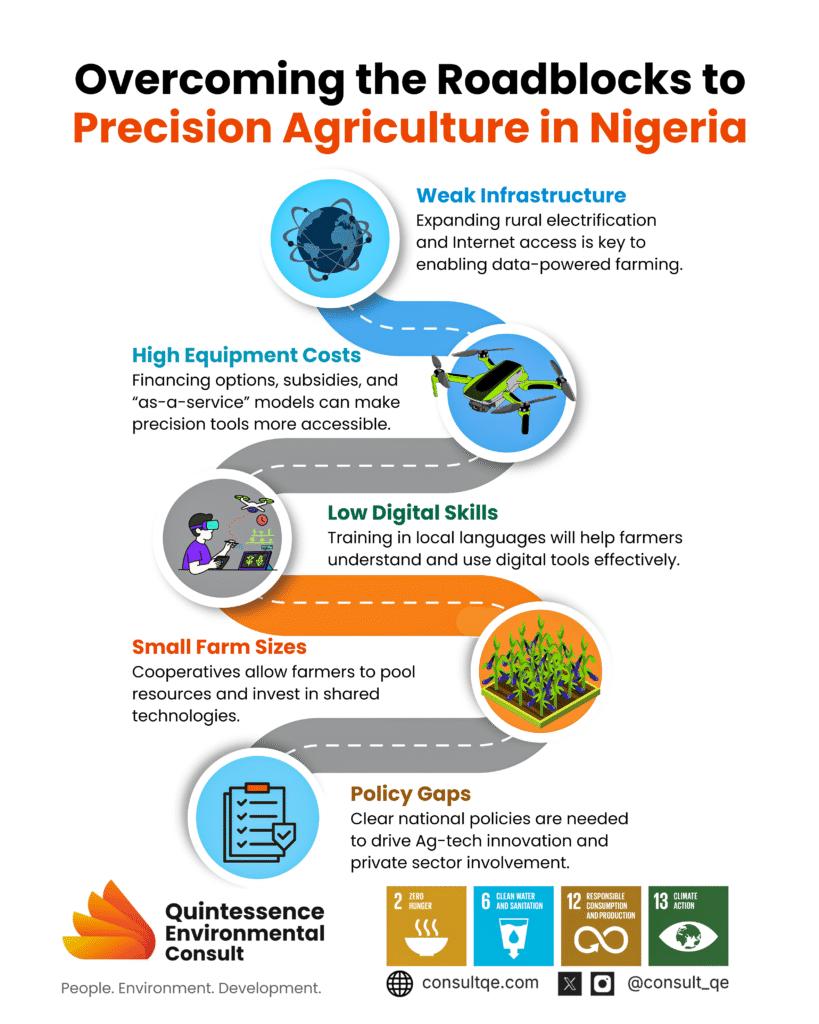
OVERCOMING THE ROADBLOCKS TO ADOPTION OF PRECISION AGRICULTURE
Despite its immense potential, the adoption of precision agriculture in Nigeria is still modest and faces significant hurdles, particularly for rural smallholder farmers:
S/N | Challenges | Proposed Solution |
|---|---|---|
1 | High Initial Costs | Government subsidies, public-private partnerships, and financing models that offer affordable leasing or “as-a-service” options for expensive equipment like drones and sensors [4]. |
2 | Infrastructure Deficits | Prioritizing investment in rural electrification, mobile network coverage, and Internet connectivity, which are essential for real-time data transfer and analysis [2]. |
3 | Digital and Technical Literacy | Developing and implementing targeted, hands-on training and extension programs in local languages, focusing on the simple interpretation of precision agriculture data and use of mobile-based platforms [4]. |
4 | Small Farm Sizes | Encouraging the formation of farmer cooperatives to jointly invest in and utilize expensive precision agriculture equipment, making it economically viable for small land holdings [1]. |
5 | Policy and Institutional Gaps | Creating clear, supportive national policies and a regulatory framework that encourages Ag-tech innovation, data sharing, and private sector investment in the agricultural space [2, 5]. |
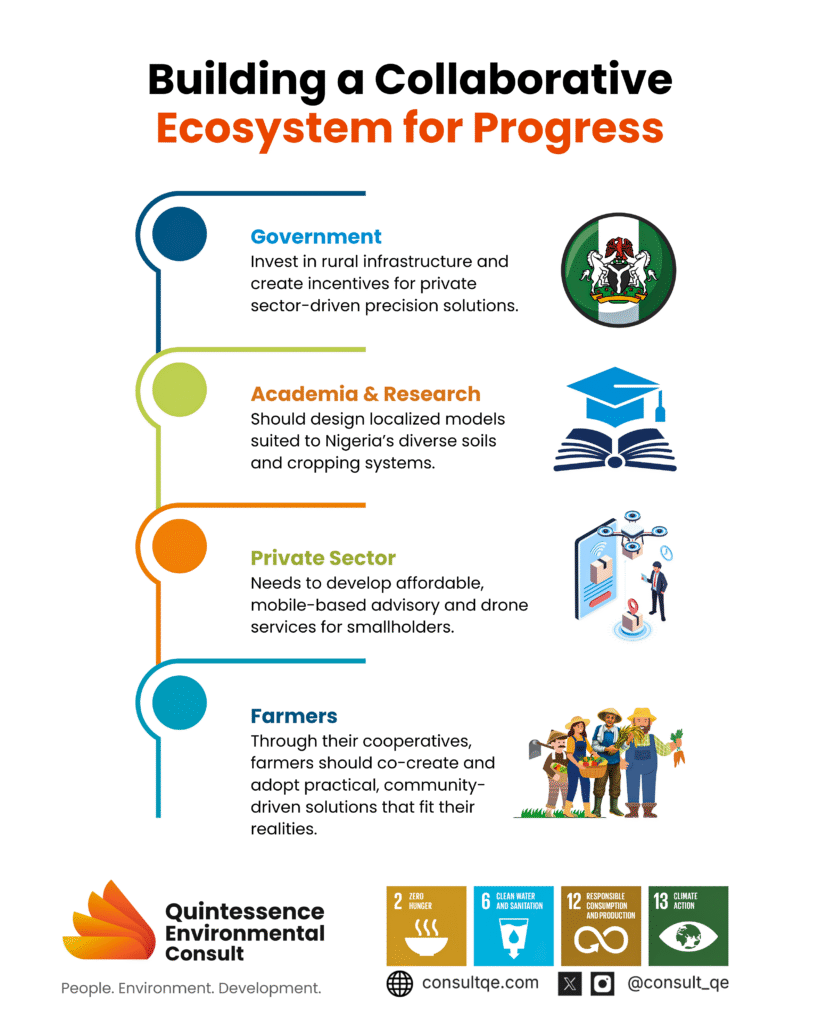
THE WAY FORWARD: A COLLABORATIVE ECOSYSTEM
The Nigerian government has demonstrated commitment through initiatives aimed at mechanization and digital platforms like the National Agriculture Growth Scheme Agro-Pocket (NAGS-AP) for input delivery [5]. To fully realize the promise of Precision Agriculture for a food-secure Nigeria, a concerted effort is needed from all stakeholders:
Government: Must invest strategically in rural infrastructure and provide incentives (tax breaks, subsidies) for the private sector to develop and deploy context-specific precision agriculture technologies.
Academia and Research: Must conduct more localized research to develop precision agriculture models tailored to the diverse soil types and cropping systems in Nigeria.
The Private Sector: Must innovate and scale affordable, user-friendly, and rugged precision agriculture solutions, particularly mobile-based advisory services and drone services.
Farmers: Must be central to the design and implementation of solutions to ensure the technology is practical and accepted.
CONCLUSION
Precision Agriculture is not just a technological upgrade; it is a fundamental shift toward sustainable, efficient, and profitable farming. By embracing this revolution, Nigeria can secure its food future, empower millions of farmers, and ensure the long-term health of its environment. The time to sow the seeds of smart farming is now.
REFERENCES
PRECISION AGRICULTURE, THE KEY TO INCREASED PRODUCTIVITY FOR SMALLHOLDER FARMERS; A CASE OF SOUTH-EAST NIGERIA https://www.paafrica.org/proceedings/?action=download&item=9480
(PDF) Precision Agriculture: Applicability and Opportunities for Nigerian Agriculture https://www.researchgate.net/publication/320268112_Precision_Agriculture_Applicability_and_Opportunities_for_Nigerian_Agriculture
Revolutionizing Farming: Precision Agriculture in Nigeria https://agricincome.com/precision-agriculture-in-nigeria/
EMPOWERING SMALLHOLDER FARMERS: PRECISION AGRICULTURE MODELS IN AFRICA (A CASE STUDY OF NIGERIA) https://www.paafrica.org/proceedings/?action=download&item=12450
Nigeria’s Strategic Policies to Strengthen Food Security https://von.gov.ng/nigerias-strategic-policies-to-strengthen-food-security/
Precision agriculture — opportunities, benefits and pitfalls of site-specific crop management in Australia (Source for the Australian case study data) – ResearchGate https://www.researchgate.net/publication/240507648_Precision_agriculture_-_opportunities_benefits_and_pitfalls_of_site-specific_crop_management_in_Australia
Farmonaut® – Apps on Google Play (Source for Farmonaut’s services)
https://learningnetwork.ictforag.com/innovation/farmonaut-satellite-based-crop-intelligence https://play.google.com/store/apps/details?id=com.farmonaut.android113 PRECISION AGRICULTURE, THE KEY TO INCREASED PRODUCTIVITY FOR SMALLHOLDER FARMERS; A CASE OF SOUTH-EAST NIGERIA (2nd African Conference on Precision Agriculture Proceedings) https://www.paafrica.org/proceedings/?action=download&item=9480
The Punch News. Annual food import bill https://punchng.com/nigeria-spends-10bn-annually-on-food-imports-minister-laments/
Participants Characteristics and Responses on Precision Agriculture Benefits (n=120) (Source for the Lagos State perception study) – ResearchGate https://www.researchgate.net/figure/Participants-Characteristics-and-Responses-on-Precision-Agriculture-Benefits-n120_tbl1_385778556
Central bank of nigeria. Agricultural https://www.cbn.gov.ng/dfd/agriculture.html
Council for Scientific and Industrial Research CSIR. (2022). Case Study Report: Transformative Farming Through Local and Remote Sensing Decision Support (No. DST/CON 0094/2020). Retrieved from https://www.dsti.gov.za/images/KP_-CSIR–Transformative_Farming_Project_Report-Fin_2022-06-24-signed.pdf
Diplomatist. (2025). Precision Farming Techniques: Global Case Studies and India’s Adoption Pathway. Retrieved from https://diplomatist.com/2025/05/26/precision-farming-techniques-global-case-studies-and-indias-adoption-pathway/
World Bank. (2010). Innovation in water, part 1: Drip irrigation. World Bank Blogs. Retrieved from https://blogs.worldbank.org/en/climatechange/innovation-water-part-1-drip-irrigation
CDA Pioneers Precision Agriculture Research Through International Partnership – Centre for Dryland Agriculture – CDA/BUK
EMPOWERING SMALLHOLDER FARMERS: PRECISION AGRICULTURE MODELS IN AFRICA (A CASE STUDY OF NIGERIA) (Source for Regional Needs Assessment)
National Agricultural Technology and Innovation Policy (NATIP) 2022-2027 (Source for NATIP)
Powering Agriculture in Nigeria through Decentralized Renewable Energy: Benefits and Policy Considerations – DOA Law (Source for EAP)
AGROXCHANGE TECHNOLOGY SERVICES LIMITED (Example of PA Practitioner)
Top 10 Agritech Companies in Nigeria (Source for AirSmat Inc., Hello Tractor).
